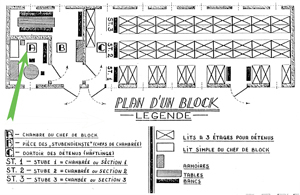Prisoner Housing

© Henri Sonnenbluck
In March 1942, work began on the creation of Camp IV for civilian workers, subsequently the Buna/Monowitz concentration camp, measuring approximately 500 x 270 meters (546 x 295 yards). The village of Monowice, situated on the building site, was torn down and leveled beforehand by the so-called external work detachment.
After the establishment of the camp, the first 600 prisoners, arriving in late October 1942, found six to eight wooden barracks in which a plank bed was available for each inmate. These barracks originally were meant to hold 55 civilian workers apiece. Built of prefabricated wooden components, each structure was about 26 meters (85 feet) long and 8 meters (26 feet) wide and was connected to the district heating system of the Buna plant. The arrival of transports in quick succession meant that the camp became overcrowded within a few weeks. As many as 250 prisoners were crammed into each barracks. On average, two, sometimes even three or four, inmates shared a bed, sleeping head to foot.
The scope of the Buna/Monowitz concentration camp was increased in several stages: Until spring 1943, the prisoners had to put in nine-hour days at I.G. Farben’s construction site, followed by three to four hours of work on the camp itself. Finally the camp was enlarged to contain 56 sequentially numbered barracks, also called “blocks” in the camp language. Among them, located next to the barracks used as housing, were nine barracks in which the prisoner infirmary was set up. Five barracks were occupied by the so-called work education camp, and the camp brothel, the kitchen, the administrative office, and the clothing depot were allocated one barracks apiece. In addition, there was a “VIP block” for up to 50 prisoner functionaries. Some of the camp’s internal work detachments and Kapos were quartered in their workshops.
Each barracks was managed by a block elder, assisted by additional prisoner functionaries. Each block was divided into two spaces: One room was equipped with three-tiered bunk beds where the majority of the prisoners slept. Another room, the so-called Tagesraum (day room, common room) was reserved for the block elder and his immediate subordinates and friends. It contained cupboards that could be locked, a table and benches, and a separate bed for each man: an unattainable luxury for “ordinary” inmates. The day room also served as the place where the soup was rationed out and where the inmates were gathered before a selection.
“Ordinary” prisoners often had only half a bunk available as a “private sphere.” Here their soup had to be consumed and their sodden clothing dried. The frequent filthiness of the prisoners’ uniforms after construction work, their lack of opportunities for physical hygiene, and the prevalence of vermin and diseases of all kinds, in combination with the district heating, gave rise to unpleasant odors and oxygen deficiency in the blocks, plaguing the inmates at night in particular and thus depriving them of much-needed sleep.
Life in the barracks was heavily regimented: After reveille, one of the bunkmates had to “construct the bed,” that is, smooth out the straw mattress, pull the thin blanket taut, and plump the pillow into a perfect square. This had to be done in great haste and on all three tiers of bunks. If a completed bed made a poor impression during the bed check, the prisoners could count on punishments in the evening. Eating breakfast inside the barracks was not permitted. The prisoners had to consume their scanty meal outdoors, whatever the weather. The Stubendienst was responsible for the cleanliness of the barracks and had to sweep and scrub the floor every day. At night, prisoners who needed to relieve themselves had to use a bucket next to the door. Once it was full, the last user, clad only in his shirt, was sent to the latrine to empty it. In the process, it was inevitable that some of the contents would splash out onto the inmate.
As a result of the hard living conditions, theft was a regular occurrence. Hence the prisoners had to keep all their belongings with them as they slept. “If a prisoner owned other treasures, he hid them together with his eating utensils in the wood shavings of his mattress or pillow.”[1]
Even worse than the conditions in the barracks were those in two huge tents set up in summer 1943 to accommodate the large numbers of new arrivals. The usual three-tiered bunks stood on gravel-covered ground, and each tent was designed for about 700 inmates. Soon, however, more than 1,000 prisoners were crowded into each of them. Stifling hot in summer and overheated in winter, the tents were in use at least until Christmas 1943, possibly even until October 1944.
(SP; transl. KL)
















